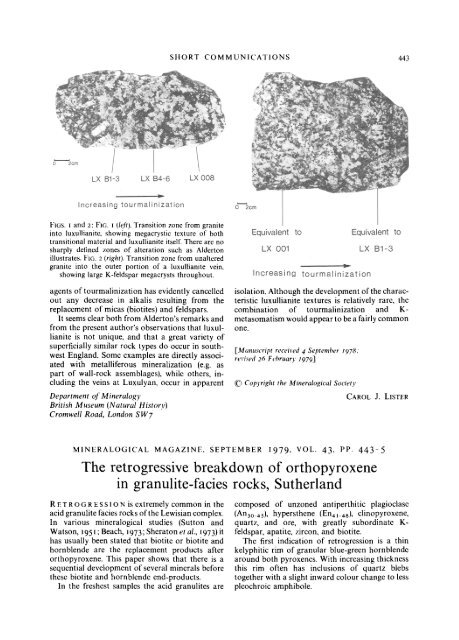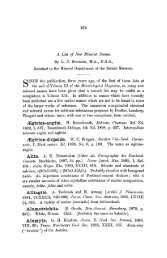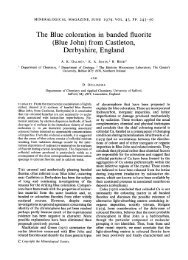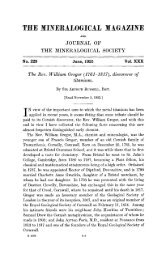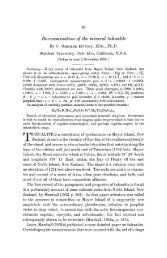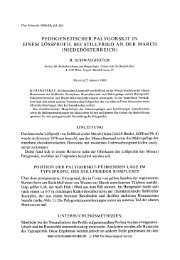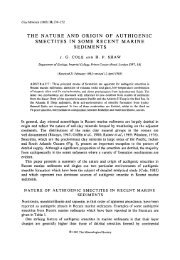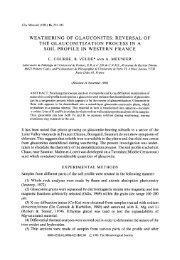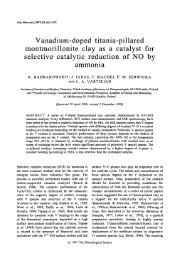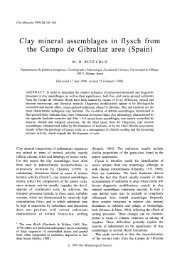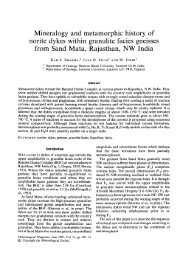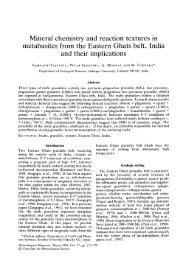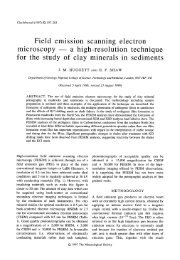The retrogressive breakdown of orthopyroxene in granulite-facies ...
The retrogressive breakdown of orthopyroxene in granulite-facies ...
The retrogressive breakdown of orthopyroxene in granulite-facies ...
You also want an ePaper? Increase the reach of your titles
YUMPU automatically turns print PDFs into web optimized ePapers that Google loves.
6<br />
LX B1-3 LX B4-6 LX 008<br />
SIIORT COMMUNICATIONS<br />
Increas<strong>in</strong>g tourmal<strong>in</strong>ization 6--"2,<br />
FIGS. [ and 2: FIG. I (left). Transition zone from granite<br />
<strong>in</strong>to luxullianite, show<strong>in</strong>g megacrystic texture <strong>of</strong> both<br />
transitional material and luxullianite itself. <strong>The</strong>re are no<br />
sharply det<strong>in</strong>ed zones <strong>of</strong> alteration such as Alderton<br />
illustrates. FIG. 2 (right). Transition zone from unaltered<br />
granite <strong>in</strong>to the outer portion <strong>of</strong> a luxullianite ve<strong>in</strong>.<br />
show<strong>in</strong>g large K-feldspar megacrysts throughout.<br />
agents <strong>of</strong> tourmal<strong>in</strong>ization has evidently cancelled<br />
out any decrease <strong>in</strong> alkalis result<strong>in</strong>g from the<br />
replacement <strong>of</strong> micas (biotites) and feldspars.<br />
It seems clear both from Alderton's remarks and<br />
from the present author's observations that luxul-<br />
lianite is not unique, and that a great variety <strong>of</strong><br />
superficially similar rock types do occur <strong>in</strong> south-<br />
west England. Some examples are directly associ-<br />
ated with metalliferous m<strong>in</strong>eralization (e.g. as<br />
part <strong>of</strong> wall-rock assemblages), while others, <strong>in</strong>-<br />
clud<strong>in</strong>g the ve<strong>in</strong>s at Luxulyan, occur <strong>in</strong> apparent<br />
Department <strong>of</strong> M<strong>in</strong>eralogy<br />
British Museum (Natural History)<br />
Cromwell Road, London SW7<br />
Equivalent to Equivalent to<br />
LX 001 LX B1-3<br />
Increas<strong>in</strong>g tourmal<strong>in</strong>ization<br />
443<br />
isolation. Although the development <strong>of</strong> the charac-<br />
teristic luxullianite textures is relatively rare, the<br />
comb<strong>in</strong>ation <strong>of</strong> tourmal<strong>in</strong>ization and K-<br />
metasomatism would appear to be a fairly common<br />
one.<br />
[Manuscript received 4 September I978:<br />
revised 26 February 1979]<br />
Copyright the M<strong>in</strong>eralogical Society<br />
CAROL J. LISTER<br />
MINERALOGICAL MAGAZINE, SEPTEMBER I979, VOL. 43, PP. 443-5<br />
<strong>The</strong> <strong>retrogressive</strong> <strong>breakdown</strong> <strong>of</strong> <strong>orthopyroxene</strong><br />
<strong>in</strong> <strong>granulite</strong>-<strong>facies</strong> rocks, Sutherland<br />
R F. T R O G R E S S I O N is extremely common <strong>in</strong> the<br />
acid <strong>granulite</strong> <strong>facies</strong> rocks <strong>of</strong> the Lewisian complex.<br />
In various m<strong>in</strong>eralogical studies (Sutton and<br />
Watson, I95I ; Beach, 1973; Sheraton et at., I973) it<br />
has usually been stated that biotite or biotite and<br />
hornblende are the replacement products after<br />
<strong>orthopyroxene</strong>. This paper shows that there is a<br />
sequential development <strong>of</strong> several m<strong>in</strong>erals before<br />
these biotite and hornblende end-products.<br />
In the freshest samples the acid <strong>granulite</strong>s are<br />
composed <strong>of</strong> unzoned antiperthitic plagioclase<br />
(An3o_~5), hypersthene (En41_4a), cl<strong>in</strong>opyroxene,<br />
quartz, and ore, with greatly subord<strong>in</strong>ate K-<br />
feldspar, apatite, zircon, and biotite.<br />
<strong>The</strong> first <strong>in</strong>dication <strong>of</strong> retrogression is a th<strong>in</strong><br />
kelyphitic rim <strong>of</strong> granular blue-green hornblende<br />
around both pyroxenes. With <strong>in</strong>creas<strong>in</strong>g thickness<br />
this rim <strong>of</strong>ten has <strong>in</strong>clusions <strong>of</strong> quartz blebs<br />
together with a slight <strong>in</strong>ward colour change to less<br />
plcochroic amphibole.
444 SHORT COMMUNICATIONS<br />
A serpent<strong>in</strong>e-like m<strong>in</strong>eral is frequently de-<br />
veloped, <strong>in</strong>side this rim, around and through<br />
the <strong>orthopyroxene</strong>. It is variable <strong>in</strong> colour, be<strong>in</strong>g<br />
reddish, yellow, yellow-brown, greenish, brown,<br />
and greenish-brown. It is also pleochroic, platy or<br />
fibrous <strong>in</strong> habit, with parallel ext<strong>in</strong>ction, low <strong>in</strong>ter-<br />
ference colours (upper first order), length slow, and<br />
is biaxial negative. In other studies on similar rocks,<br />
a comparable m<strong>in</strong>eral has been tentatively identi-<br />
fied as chlorite (Howie, 2955; O'Hara, I96I), bow-<br />
l<strong>in</strong>gite (Nockolds, I94o), bastite or anthophyllite<br />
(Stewart, [947), amphibole (O'Hara, I960, serpo-<br />
phite or anthophyllite (Green and Jorde, I97I),<br />
serpent<strong>in</strong>e (Groves, I935; Beach, I973) , and a<br />
'serpent<strong>in</strong>ous-type' m<strong>in</strong>eral (Himmelberg and<br />
Ph<strong>in</strong>ney, i967). Some difficulty <strong>in</strong> identification<br />
was experienced <strong>in</strong> the present work but optical<br />
studies and qualitative scans us<strong>in</strong>g the electron<br />
microprobe <strong>in</strong>dicate that serpent<strong>in</strong>e is probable.<br />
Certa<strong>in</strong>ly the m<strong>in</strong>eral is asbestiform <strong>in</strong> many<br />
samples and is ma<strong>in</strong>ly a Fe-Mg silicate. Frequently<br />
<strong>orthopyroxene</strong> is seen either with marg<strong>in</strong>al alter-<br />
ation to serpent<strong>in</strong>e or, more rarely, completely<br />
pseudomorphed by the latter. In both cases the<br />
~ <strong>orthopyroxene</strong> <strong>in</strong> fresh <strong>granulite</strong>s<br />
hornblende rim " ~ ~ serpent<strong>in</strong>e rim<br />
\ /<br />
~ 2 coronas<br />
i<br />
fibrous cumm<strong>in</strong>otonite between ~<br />
kelyphitic hornbrende rim and ~.|II~'~II~ transition from hornblende to act<strong>in</strong>o(ite<br />
serpentenised <strong>orthopyroxene</strong> cor~________~/<br />
cumm<strong>in</strong>gtonite<br />
rare carbonate<br />
core<br />
granule<br />
with<br />
~k~.~.l..gmarg<br />
C"c~]~"P~<br />
'hal<br />
.<br />
development <strong>of</strong> biotite<br />
deve p e t ..~%J2 ~ gg ecoate layer after<br />
oP; efejt~t2 ial " ~ J {(.~cu mm,n gto n,te<br />
biotite and x'~<br />
ore clusters~<br />
f ~<br />
,"~Tr,t~ ~ l%<br />
~=o aggregate core<br />
~ q u artz <strong>in</strong>clusions<br />
r ec r~l,~..~ ~ <strong>in</strong> core<br />
1<br />
~ n e w fabric <strong>in</strong> shear belts<br />
FIG. I. Idealized diagram illustrat<strong>in</strong>g the <strong>retrogressive</strong> <strong>breakdown</strong> <strong>of</strong> <strong>orthopyroxene</strong> <strong>in</strong> Lewisian acid <strong>granulite</strong>s<br />
show<strong>in</strong>g the late divergence <strong>of</strong> the sequence <strong>in</strong>to (a) biotite and (b) hornblende plus m<strong>in</strong>or biotite end products.
kelyphitic hornblende rim may be absent. Read<br />
(1935) reported a similar phenomenon where some<br />
members <strong>of</strong> a pyroxene <strong>breakdown</strong> sequence were<br />
miss<strong>in</strong>g. In the present study it may <strong>in</strong>dicate that<br />
serpent<strong>in</strong>e predated the hornblende <strong>in</strong> some<br />
<strong>in</strong>stances.<br />
Next, there is the development <strong>of</strong> a third m<strong>in</strong>eral<br />
between the marg<strong>in</strong>al kelyphitic rim and the ser-<br />
pent<strong>in</strong>e. This consists <strong>of</strong> felted mats <strong>of</strong> fibrous<br />
cumm<strong>in</strong>gtonite, oriented parallel to the orig<strong>in</strong>al<br />
cleavage and around remnant <strong>orthopyroxene</strong><br />
cores. It is also homoaxial to the hornblende<br />
granules on which it nucleates. Similar <strong>breakdown</strong><br />
<strong>of</strong> <strong>orthopyroxene</strong> was noted by Deer (I935) , Read<br />
(1935), and Himmelberg and Ph<strong>in</strong>ney (i 967). Trails<br />
<strong>of</strong> small iron-ore granules can be seen parallel to<br />
the prismatic needles, and rare carbonate granules<br />
sometimes occur when serpent<strong>in</strong>ized orthopy-<br />
roxene is totally consumed.<br />
<strong>The</strong> outer marg<strong>in</strong>s <strong>of</strong> the kelyphitic hornblende<br />
frequently show the subsequent development <strong>of</strong> a<br />
dull-brown biotite similar to that mantl<strong>in</strong>g ore<br />
granules but quite different from the reddish-<br />
brown primary biotite.<br />
Next, cumm<strong>in</strong>gtonite gra<strong>in</strong>s, which now form the<br />
cores <strong>of</strong> many <strong>of</strong> these complex pseudomorphs, are<br />
gradually replaced by aggregates <strong>of</strong> extremely<br />
m<strong>in</strong>ute quartz, biotite, ore, epidote, calcite,<br />
hornblende, and possibly chlorite. This replace-<br />
ment occurs at the contact <strong>of</strong> cumm<strong>in</strong>gtonite with<br />
kelyphitic amphibole. Gradually these aggregates<br />
<strong>in</strong>crease <strong>in</strong> volume until they alone exist as cores<br />
rimmed by kelyphitic hornblende.<br />
<strong>The</strong> kelyphitic rim next <strong>in</strong>creases at the expense<br />
<strong>of</strong> the aggregate layer and large poikiloblastic<br />
hornblendes with abundant quartz <strong>in</strong>clusions are<br />
the end result. In numerous shear belts that cut the<br />
acid <strong>granulite</strong>s, the <strong>retrogressive</strong> sequence has<br />
proceeded furthest. Here a new m<strong>in</strong>eral fabric,<br />
def<strong>in</strong>ed by a preferred orientation <strong>of</strong> recrystallized<br />
hornblende, is developed. An idealized diagram <strong>of</strong><br />
the <strong>retrogressive</strong> sequence is shown <strong>in</strong> fig. I.<br />
Discussion. <strong>The</strong> <strong>in</strong>itial <strong>breakdown</strong> <strong>of</strong> ortho-<br />
pyroxene was probably produced by reaction with<br />
plagioclase to give hornblende only, but this was<br />
quickly superseded by a reaction giv<strong>in</strong>g hornblende<br />
and quartz as products. With <strong>in</strong>creas<strong>in</strong>g thickness<br />
<strong>of</strong> the hornblende rim there was the development <strong>of</strong><br />
Al-poor amphibole, with quartz <strong>in</strong>clusions, on the<br />
<strong>in</strong>ner marg<strong>in</strong>. This development <strong>of</strong> act<strong>in</strong>olitic am-<br />
phibole is seen <strong>in</strong> the colour change with<strong>in</strong> the rim.<br />
Possible reasons for this reaction change are either<br />
a decl<strong>in</strong>e <strong>in</strong> the available supply <strong>of</strong> constituents<br />
from anorthite or a change <strong>in</strong> the pressure-<br />
Department <strong>of</strong> Geology, University <strong>of</strong> Natal<br />
K<strong>in</strong>g George V Avenue, Durban 4ool<br />
SHORT COMMUNICATIONS 445<br />
temperature conditions lead<strong>in</strong>g to a new amphibole<br />
composition.<br />
<strong>The</strong> appearance <strong>of</strong> serpent<strong>in</strong>e only requires<br />
hydration <strong>of</strong> <strong>orthopyroxene</strong> with decreas<strong>in</strong>g tem-<br />
perature and gives quartz as a by-product. Later<br />
<strong>in</strong>creas<strong>in</strong>g temperature is needed to give cum-<br />
m<strong>in</strong>gtonite from reaction between serpent<strong>in</strong>e and<br />
quartz. <strong>The</strong> Fe/Mg ratio <strong>of</strong> cumm<strong>in</strong>gtonite is always<br />
less than that <strong>of</strong> the orig<strong>in</strong>al <strong>orthopyroxene</strong>, which<br />
is consistent with the development <strong>of</strong> iron-ore<br />
granules with<strong>in</strong> the cumm<strong>in</strong>gtonite.<br />
If free diffusion <strong>of</strong> the anorthite constituents was<br />
still possible a further reaction, which would aug-<br />
ment the hornblende rim, is that <strong>of</strong> cumm<strong>in</strong>gtonite,<br />
anorthite, and water.<br />
<strong>The</strong> subsequent appearance <strong>of</strong> the 'aggregate'<br />
zone may be due to the <strong>breakdown</strong> <strong>of</strong> cum-<br />
m<strong>in</strong>gtonite, possibly <strong>in</strong> the presence <strong>of</strong> a high CO2<br />
partial pressure, or to reaction between cum-<br />
m<strong>in</strong>gtonite and the act<strong>in</strong>olitic <strong>in</strong>ner part <strong>of</strong> the<br />
kelyphitic rim. <strong>The</strong> latter po<strong>in</strong>t may be unlikely<br />
s<strong>in</strong>ce this rim eventually grows to replace all the<br />
other m<strong>in</strong>erals. F<strong>in</strong>ally, secondary biotite is the<br />
eventual end-product <strong>of</strong> retrogression. This is<br />
ma<strong>in</strong>ly produced by reaction between the ortho-<br />
pyroxene <strong>breakdown</strong> products and K feldspar<br />
from antiperthite. This biotite is usually sub-<br />
ord<strong>in</strong>ate to the poikiloblastic hornblende but <strong>in</strong><br />
rare cases is the only mafic product <strong>of</strong><br />
retrogression.<br />
REFERENCES<br />
Beach (A.), 1973. J. Petrol. 14, 231 47.<br />
Deer (W. A.), I935. Q. J. Geol. Soc. 91, 47-76.<br />
Green (T. H.) and Jorde (K.), 197I. Norges Geol. Unders.<br />
270, 47-76.<br />
Groves (A. W.), I935. Q. J. Geol. Soc. 91, I5o-2o 7.<br />
Himmelberg (G. R.) and Ph<strong>in</strong>ney (W. C.), I967. J. Petrol.<br />
8, 325-48 .<br />
Howie (R. A.), 1955. Trans. R. Soc. Ed<strong>in</strong>. 62, 725-68.<br />
Nockolds (S. R.), I94o. Q. J. Geol. Soc. 96, 451 5Io.<br />
O'Hara (M. J.), 1961. J. Petrol. 2, 248 76.<br />
Read (H. H.), 1935. Q. J. Geol. Soc. 91, 591 634.<br />
Sheraton (J. W.), Sk<strong>in</strong>ner (A. C.), and Tarney (J.), 1973.<br />
<strong>The</strong> Early Precambrian <strong>of</strong> Scotland and Related Rocks <strong>of</strong><br />
Greenland, eds. Park (R. G.) and Tarney (J.). University<br />
<strong>of</strong> Keele.<br />
Stewart (F. H.), 1947. Q. J. Geol. Soc. 102, 465.<br />
Sutton (3.) and Watson (J.), 1951. Ibid. 106, 24I-3O8.<br />
[Manuscript received 5 December 1978;<br />
revised 2I January 1979]<br />
(~ Copyright the M<strong>in</strong>eralogical Society<br />
A. KERR


